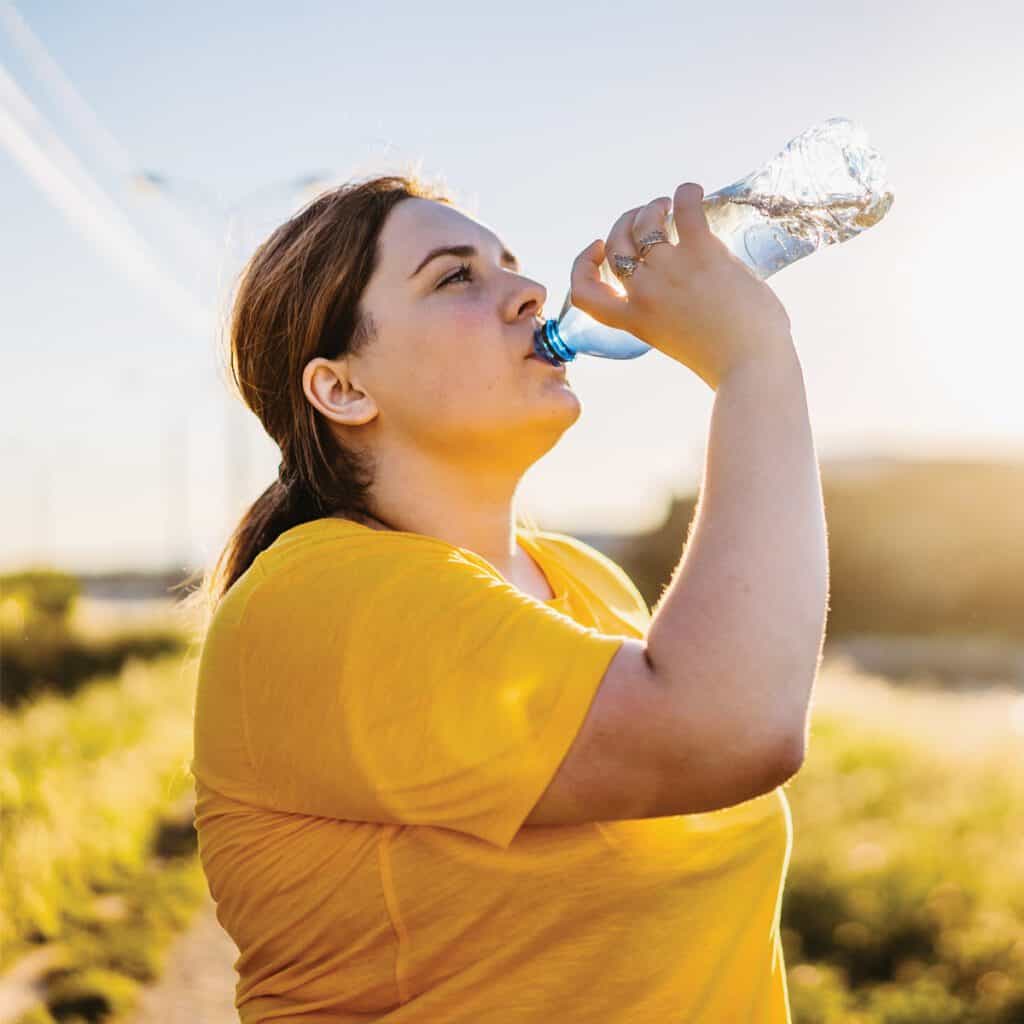Heat Stroke and Summer Safety: How to Beat the Heat
The human body maintains a consistent core temperature of 97.7 to 99.5 degrees. However, a summer heat wave can put that equilibrium at risk. Here, we speak with local physicians about heat-related illness and how to stay safe while enjoying the summer sun.


When heat spikes in the summer, your body knows how to regulate its temperature. Sweat evaporating off your body can cool you to the tune of two degrees for every teaspoon you perspire. But with increased humidity, the moisture in the air starts to impede this transfer.
“The primary cause of heat-related illness is the body’s inability to cool itself efficiently, leading to overheating. This can happen during prolonged exposure to high temperatures or excessive physical exertion in hot environments. In these conditions, the body’s cooling mechanisms, such as sweating, can become overwhelmed. Risk factors include high humidity, direct sun exposure, and limited airflow, which all exacerbate the body’s heat load,” explains Dr. Sudave Mendiratta, an emergency medicine physician at Erlanger.
Heat-related illness is a continuum, meaning a chain of progressive symptoms that increase in severity as you get further from your body’s ability to regulate.
Hydration plays a crucial role in preventing heat-related illnesses by helping maintain the body's temperature and ensuring efficient function of physiological processes. Proper hydration means drinking enough fluids before, during, and after exposure to heat, even if you don't feel thirsty. Ideally, this includes frequent consumption of water or electrolyte-replenishing drinks, particularly during intense activity or high heat exposure. Good hydration means that you should still be using the restroom, regardless of how much you are sweating.”
Dr. Mendiratta
Heat Cramps
Heat cramps are the mildest form of heat-related illness and involve painful muscle spasms, typically in the legs and abdomen. This involuntary muscle tightening occurs when the body gets too hot and nutrients are lost through sweat. Heat cramps can be treated with hydration and by gently massaging and applying an ice pack to the cramping muscles.
Heat Exhaustion
Heat exhaustion is the body’s response to an excessive loss of water through sweating. Symptoms can include headache, nausea and vomiting, fatigue, dizziness, low blood pressure (hypotension), irritability, and a heart rate over 100 beats per minute. “Heat exhaustion is treated by moving out of the hot environment, removing clothing, and laying down with the legs elevated,” says Dr. Charles Tapley of CHI Memorial. Seek medical attention if nausea leads to vomiting or if symptoms worsen or last longer than one hour.



Heat Stroke
The most serious heat-related illness, heat stroke, is an emergency. This condition occurs when an individual’s core temperature has reached 104 degrees or higher and is often a result of untreated heat exhaustion. In addition to symptoms of heat exhaustion, heat stroke includes an altered mental status. This can include confusion, slurred speech, seizures, and loss of consciousness.
Because heat stroke can lead to organ failure even after cooling the body, medical treatment is critical. “For heat stroke, which is a severe medical emergency, treatment must be immediate and includes cooling the person rapidly using whatever means available, such as ice baths or cool water immersion, while waiting for emergency services. Intravenous fluids may be administered to address severe dehydration,” says Dr. Mendiratta. Contact emergency services immediately if you recognize someone displaying signs of heat stroke.
There are two types of heat stroke:
Classic Heat Stroke
Common among the elderly, infants, and the immunocompromised, classic heat stroke is caused by exposure to extreme heat during summer heat waves. Classic heat stroke is not always accompanied with sweating; instead, the skin is often dry.
Exertional Heat Stroke
Exertional heat stroke is most often observed in young, active individuals. “The primary cause is strenuous activity while being exposed to high temperatures and/or humidity,” says Dr. Tapley. “Wearing excessive clothing, equipment, and gear are contributing factors. Those at greatest risk include outdoor workers, military personnel, and athletes.”
Preventing Heat-Related Illness
Protecting yourself in the sun requires planning ahead. Here are steps you can take to maintain a safe core temperature:
Stay hydrated. During hot temperatures, you will need to increase your fluid intake. “The CDC recommends drinking eight ounces of water every 15 to 20 minutes to replace water lost by sweating while physically active in extreme temperatures,” notes Dr. Tapley.
Wear lightweight clothing. When dressing for hot weather, opt for light-colored and loose-fitting articles of clothing made of breathable fabrics such as cotton and linen.
Douse your skin. You can mimic the heat exchange that happens when you sweat by standing in the rain or misting yourself with cool water. Or, head indoors for a cool shower or bath.
Take regular breaks. Set aside time to cool off in shaded or air-conditioned areas.
Schedule carefully. “Avoid activities during extreme temperatures,” advises Dr. Tapley. “When avoidance is not possible, frequent water breaks, scheduled rest, and close monitoring are recommended.”
Keeping Kids Safe
“Physical activity, sunlight, and fresh air are all important for a child’s health. However, during the summer when temperatures increase, they can be more susceptible to heat-related illnesses. Children’s bodies have more trouble regulating temperature than those of adults. Children have a higher surface area-to-body mass ratio which causes them to absorb more heat. They also take longer to increase sweat production and otherwise adapt to warmer environments. These issues can allow a child’s body temperature to rise three to five times faster than adults,” explains Dr. Michael Tigar, a pediatrician with Galen Pediatrics.
To help children stay safe, Dr. Tigar advises parents and guardians to, in addition to hydration and general precautions, not let kids play intensely outdoors during the hottest hours of the day (noon to 4 p.m.), head indoors for breaks when a child feels or looks overheated, and never leave kids alone in parked cars. “Summer is a time for lots of outdoor fun. Taking these steps will help ensure a safe one as well,” he says.



Sudave Mendiratta, MD
Emergency Medicine Physician, Erlanger



Charles Tapley, MD
Family Medicine Physician, CHI Memorial Family Practice Associates - North River



Michael Tigar, MD
Pediatrician, Galen Pediatrics

